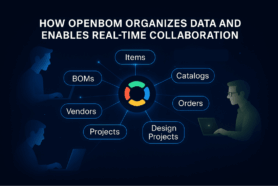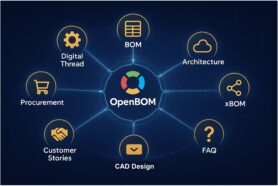
Part numbers play a critical role in product data management for any engineering or manufacturing organization. Choosing the right part numbering schema is a decision that has long-term consequences, as it becomes a foundational aspect of your company’s operational efficiency. Whether you’re a startup or an established company, altering part numbers down the road can be complex and time-consuming, often leading to disruptions in your processes, data consistency, and communication. Therefore, it’s essential to approach part numbering with care and foresight.
The schema you choose for part numbers can affect multiple areas:
- Data searchability and organization
- Collaboration between teams (engineering, manufacturing, procurement, etc.)
- System integrations (PLM, ERP, PDM systems)
- Traceability of parts across the product lifecycle
This makes part numbering a topic that deserves thoughtful consideration upfront.
Significant (Smart) vs. Insignificant (Surrogate) Numbers
There are two main philosophies when it comes to part numbering systems: significant (smart) numbers and insignificant numbers. Each has its advantages and trade-offs.
- Significant (Smart) Part Numbers
In this approach, part numbers are designed to embed information that is meaningful and easy to interpret. For example, a part number like ENG-1234 might denote that the part belongs to the engineering department (ENG) and is the 1,234th part. This format makes it easy to categorize and filter parts based on their part number alone.
Pros:- Enables quick identification of parts.
- Allows for manual filtering and searching based on part number structure (e.g., ENG for engineering parts, MFG for manufacturing).
- Cons:
- Can become difficult to maintain over time as the schema gets more complex.
- The logic behind significant part numbers must be consistently applied, which can become challenging as the company scales or expands into new products.
- Insignificant Part Numbers
Insignificant part numbers are usually sequential or random numbers with no embedded meaning, such as 123456 or AB12345. This approach focuses on simplicity and minimizes human error by relying on system attributes to carry the part details instead of embedding them in the part number itself.
Pros:- Simplifies part number generation and maintenance.
- Avoids inconsistencies that arise from trying to encode meaning in part numbers.
- Ideal for automated processes and integrations with other systems like ERP or PDM, where the part number is merely an identifier and the metadata is stored elsewhere.
- Cons:
- Not intuitive to humans; without the use of a system or database, it’s difficult to glean any information about the part.
- Typically, it requires efficient software systems (like OpenBOM) to manage the attributes and metadata of parts.
Best Practices and Mistakes to Avoid
When designing a part numbering system, there are several pitfalls that many companies encounter, especially when transitioning from manual or legacy systems. Here are common mistakes to avoid:
- Leading Zeros:
Avoid leading zeros (00012345). Different systems interpret them differently, and it can lead to confusion when part numbers are exported or shared between platforms. For example, in some software environments, leading zeros are stripped, creating mismatches in part number formats. - Use of Underscores:
While underscores (_) might seem like a good separator between elements in a part number, they are often hard to communicate verbally and can be visually ambiguous in certain fonts or text systems. Hyphens (-) or spaces are generally better alternatives. - Use of Letters:
Mixing letters with numbers can lead to confusion. Characters such as O (letter) and 0 (number), or I (letter) and 1 (number) are easily mistaken for each other, especially in verbal communication or certain fonts. Sticking to a purely numeric system or clearly differentiating letters can help avoid errors.
Here’s a helpful video that further explores different part number schemas and their applications in various industries.
What is the Best Approach for Managing Part Numbers with OpenBOM?
OpenBOM offers a flexible, property-based approach to part number management, which allows you to avoid the pitfalls of overly complex or “smart” part numbers. The key advantage of OpenBOM is that it emphasizes metadata and attributes, meaning the need to embed information in the part number itself is greatly reduced.
- Flexible Properties:
OpenBOM allows you to define a set of properties or attributes for each item (such as material, manufacturer, supplier, etc.), which means that all critical information about a part can be managed via these properties rather than encoded into the part number itself.
For example, instead of embedding product category information (like ENG for engineering or SER for serial parts) directly into the part number, OpenBOM would recommend using a simple numeric part number (e.g., 123456) and assigning a property to classify the item. This makes the system more flexible and scalable in the long run. - Reduced Smart Characters:
If you still need to differentiate large groups of item types (e.g., for engineering, manufacturing, or service parts), OpenBOM allows you to use minimal smart codes in your part numbers while leveraging other item properties to manage data effectively.
OpenBOM Part Number Setup
OpenBOM makes it easy to establish and maintain part numbers with the following features:
- Multiple Part Number Schemas:
OpenBOM allows you to set up different part number schemas for each catalog. This means that engineering items, purchased components, and manufacturing parts can each follow their own numbering schema, which is helpful when different departments or teams have different needs. - Uniqueness:
OpenBOM ensures the uniqueness of part numbers across catalogs and alerts you if there are any duplicate part numbers, helping you avoid errors in item identification. - Automatic Part Number Generation:
OpenBOM provides a mechanism for automatically generating the next available part number. Whether you’re adding parts via the web editor or through a CAD integration, OpenBOM generates unique part numbers in real-time to ensure consistency and accuracy.
What’s Coming Next in OpenBOM?
OpenBOM is continuously improving its part numbering capabilities to meet the growing needs of its users. Here’s a sneak peek of upcoming features:
- Multi-catalog centralized Part Number Setup :
In future updates, OpenBOM will introduce a centralized part number setup, allowing part numbers to be managed across multiple catalogs in a unified way. Currently, the part number setup is done per each catalog individually. This will provide more flexibility for managing part numbers at a global level within the organization. - Part Number Duplication Report:
This upcoming feature will generate reports that help identify duplicate part numbers, particularly in cases where data from CAD systems may have caused inadvertent duplicates (e.g. when multiple configurations or versions of an assembly use the same part number).
Conclusion
Part numbering is often a subject of debate among teams and organizations because it impacts so many aspects of daily operations. While there is no one-size-fits-all solution, adopting best practices and leveraging tools like OpenBOM can help simplify the process. By avoiding overly complex part numbers and relying on flexible properties for item management, you can streamline your part numbering system and ensure a more efficient, scalable, and error-free workflow.
Try OpenBOM today for free and experience how flexible part number management can enhance your operations.Best regards,
Oleg
Join our newsletter to receive a weekly portion of news, articles, and tips about OpenBOM and our community.










